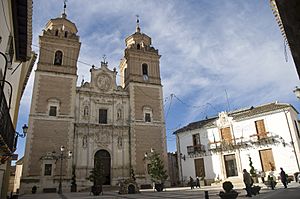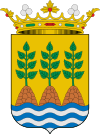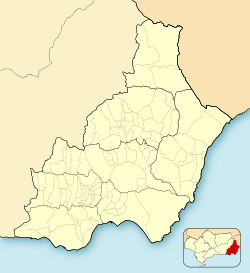Vélez-Rubio facts for kids
Quick facts for kids
Vélez-Rubio
|
|||
|---|---|---|---|

Church of Ntra. Sra de la Encarnación
|
|||
|
|||
| Country | |||
| Community | |||
| Province | |||
| Comarca | Los Vélez | ||
| Area | |||
| • Total | 282 km2 (109 sq mi) | ||
| Elevation | 847 m (2,779 ft) | ||
| Population
(2018)
|
|||
| • Total | 6,630 | ||
| • Density | 23.51/km2 (60.89/sq mi) | ||
| (INE) | |||
| Time zone | UTC+1 (CET) | ||
| • Summer (DST) | UTC+2 (CEST) | ||
Vélez-Rubio is a town in the province of Almería, which is part of the Andalusia region in Spain. It is a place with a long history and interesting sights. About 6,630 people live here. The town is located about 847 meters (2,779 feet) above sea level.
Contents
History of Vélez-Rubio
People have lived in the Vélez-Rubio area for a very long time. In fact, humans were here as far back as 30,000 years ago!
The town you see today started growing in the 1400s and 1500s. This is when people called Moriscos and Christians began living together in the Fatín area. They built the town around its church and town hall.
Vélez-Rubio grew a lot in the 1700s and 1800s. During this time, many of its wide streets and beautiful buildings were constructed.
Places to Visit in Vélez-Rubio
Vélez-Rubio has several interesting places to explore.
Church of the Virgin of the Incarnation
This church is the most important religious building in the entire province of Almería. It is a beautiful and historic place to see.
Ethnographic Museum
The Ethnographic Museum shows how people used to live in Vélez-Rubio. You can learn about their daily lives, tools, and traditions.
Convent of the Immaculate Conception
This is a historic convent, which is a building where a community of nuns lives. It is another important landmark in the town.
Holy Week Celebrations
Holy Week is a very important time in Vélez-Rubio. Many special events and processions take place. Different groups, called brotherhoods, organize these events.
- Venerable Brotherhood of Our Father Jesus from Nazareth: This group is also known as "the slaves." It was started a long time ago in the 1500s.
- Brotherhood of Jesus' Holy True Cross and Blood: People often call this group "Christ of the Coffin."
- Traditional Brotherhood of Our Lady of the Sorrows: This group is known as "the coffees." It was founded in the 1800s.
- Brotherhood of the Holy Christ of the Pardon and Afflicted: This group is sometimes called "the porcelains."
See also
 In Spanish: Vélez-Rubio para niños
In Spanish: Vélez-Rubio para niños






